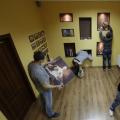1s 8.3 printer is not set by default
Knowing how to change a printer in 1C, as well as knowing how to connect and configure printers in 1C, helps speed up printing and improve customer service.
How to connect a printer
The printer is connected in two stages:
- To connect a printer to a PC, connect them with a wire and install a driver that matches the model of the printer, PC OS and version 1C. To print from a remote server, you need to install the universal driver on the server and on the local machine, and open the printer itself for network access.
- After the printing device is displayed on the PC, you need to connect it to the 1C program. To do this, run the program, add a new device and enter the basic printer settings in the appropriate fields. When printing remotely, you will have to select the desired printer manually each time.
How to change and set up a printer
If several printers are connected to the PC, then 1C: Enterprise will use the one specified in the default settings. But only until the user selects another printer, setting up the printing of a document. After that, the program will focus on the last choice. You can change the printing device in the "Page Setup" while setting the print options for a document.
The most problematic moment when printing is the discrepancy between the label sizes. How to adjust the document size?
- Specify the dimensions of the label in 1C: File menu, and then - Page Setup.
- Find printers in the Control Panel, select a barcode printer and open its context menu. In Print Server Properties, create a form with label sizes. In the future, when printing from 1C, select this form.
These are the basic settings for a printing device in 1C. The remaining settings vary depending on the version of the program - 1C 8.3 or 1C 7.7. If you encounter any difficulties, we recommend contacting specialists to debug the program.
Actually, barcode automation starts with product labeling received at the company's warehouse. AND 1C has built-in tools for generating a barcode for each commodity item in the nomenclature of the enterprise, as well as a component for generating the actual barcode for printing on label printer. Thus, the client is only left with the right so that the finished self-adhesive labels meet the requirements of the enterprise in terms of shelf life, resistance to various external factors, etc.
Determine what type of label printer you want to connect to 1C:
You will immediately ask why? ... Yes, just to avoid unnecessary manipulations with the printer itself (it often happens that the equipment is in an indefinite state - "dump", "semi-calibration", "download new firmware", etc.) and you are trying adjust the page size in 1C...
Since you are reading these lines, it means that you have encountered certain problems when setting up or installing label printer, we recommend that you "reset" the label printer to "factory settings" and continue to follow our instructions below.
Label printers, and accordingly there are two types of labels: thermal printers, they print by heating labels and thermal transfer printers, they print through a special ink ribbon -. Here it is important to know:
are not suitable for printers of the first type - thermal printers, they do not respond to heat. It is very easy to check which labels you have, just heat the label, for example, with a lighter, if it darkens, then the label is intended for thermal printing.
In other words, you need to check the consumables that you plan to use with this type of printer. Remember, there is always a picture on the body of the label printer how to refill the ribbon (from our practice - 30% of problems in the first two months after buying a label printer is not the correct use or refilling of consumables) how can you not remember old Murphy - "In any set of initial data the most reliable value, which does not require any verification, is erroneous .. "
1C requirements for a label printer:
Few people clarify to the client what, in fact, program 1C imposes certain requirements on the label printer: a more powerful processor and a large amount of RAM.
This is due to the peculiarity of the work of 1C itself: each label, in fact, is sent for printing separately, even if you have given the task to print 100 copies of the same label.
We think that many users still remember the time when the maximum speed of printing labels from 1C was a maximum of 20% of the label printer declared in the technical specifications. The reason is precisely in a weak processor and a small amount of RAM - the label printer had to process each incoming label as a separate task with all the ensuing time delays.
Therefore, if you are using special software (LabelView, BarTender, etc.) for a label printer, the specifications when printing labels from 1C almost come to the fore. You should also take into account that the amount of printer memory affects the length of the label (or label) - the more memory, the longer the label.
Working with the label printer driver:
Modern driver versions barcode label printers allow you to connect the label printer to the Windows operating system. Barcode printer driver allows you to manage all printing options, manage the sizes of labels used, test the printer, etc. The latest versions of drivers you canor contact.
Always check with your supplier to find out exactly what parameters the driver of the label printer you offer allows you to control - your convenience depends on this.
Whatever your printer and operating system version, the label printer connects like a regular printer. The difficulty lies only in setting the correct size of paper, margins, headers and footers and linking it all to a specific label or price tag in 1C. But sometimes it takes several hours to set up the label format and fit to the paper...
So, to set up a label printer in 1C, you need to do the following:
1. Install or check for the presence of the "BarCode" font in the Windows system/Eangnivc.ttf; If the font is not installed, download it - to do this, follow the link Next, copy it to the standard folder with the fonts of your operating system. As a rule, this is the Windows/Fonts directory (or copy eang000.ttf to the Control Panel - Fonts folder). If the font is found in the system, but, as it turns out later, that the barcode is not printed in the program, go to the font directory. Find this file there and double-click on it with the left mouse button. This action should activate it and allow you to use the barcode in 1C.
2. Install or check for the presence in the Windows system of the components "barcode.ocx" and "1СBarCode.dll"(the files are available in the 1C:Enterprise distribution, on the ITS disk or in the user's personal account https://portal.1c.ru of the 1C:Enterprise software system); To properly install the "barcode.ocx" component, do the following: install ActiveBarcode, copy the Barcod.ocx file to the C:\Windows\ directory. Here it is important terminal window(Click the start button, and select Run, command prompt, cmd) should be opened with the command "Run as administrator"(available by clicking the right mouse button). The programs for registering 32-bit and 64-bit ActiveX in 64-bit Windows are different, but they are both called regsvr32.exe. Therefore, to guarantee the launch of 32-bit regsvr32, you should type the command "c:\windows\syswow64\regsvr32.exe Barcode.ocx" in the terminal window
3. Adjust barcode label size in the print server: Start -> Settings -> Printers and Faxes. Next File -> Server property. Here you create or select a label size. Or for WINDOWS-10, the print server setup looks like this:

4. Customize barcode label size in your label printer driver, first "Default", then in the "Basic" tabs of the driver. Important: when printing from 1C, the "default" driver settings are used, which are indicated in the "Defaults" tab (by clicking the button).
5. Check printer operation from Word or Excel. It is important to set the page settings - click on the toolbar - file - page settings, select the printer and paper size (in your case, the label size), the selected size must match the physical size of the label. On the toolbar, click the "view only" icon, the label data should fit on one page, if not, then close the label view mode, there is a "view only" icon on the bottom toolbar, if it is on, turn it off. Edit the label, by changing its size, until it "fits" on a single page view. The same manipulations are valid for working in the environment. 1s.
6. Set up the work label size in 1C (configurator). First you need to check the printer settings in 1C 8.X. This is done through the menu "Tools - Users - List of users" / select a user / - retail trade and shop equipment - label printing. Here for print settings: 1). you need to make sure that the printer name matches the printer name in the Windows environment. 2). Further, for customization, it is better to print labels with a preview. Here the scale changes, the page settings button, you can also check the printer settings, set or check the height and width of the label. The font size, for example, in the "name" field, as well as the size of the barcode, is configured in the configurator. Initially, the configuration is blocked from any changes, in order to be able to edit it, you need to: go to the configurator -> Configuration -> Support -> Support settings -> Allow changes. Next, we find the label, Configuration window (located on the left of the screen, if not, select Ctrl + Shift + C) -> Open the General group -> General layouts -> Label, open the label, a spreadsheet appears, if changes are allowed, then by right-clicking on any element of the table, you can call up the context menu, and select Properties in it and continue editing (see also the menu on the right).
How to add a seal, signature and logo to the printed form of the invoice for payment to the buyer (for 1C: Accounting 8.3, edition 3.0)
2018-07-27T09:42:51+00:00Organizations often ask to embed a logo and signature seal directly on the invoice for payment to the buyer. From this, the account looks more solid and representative. Fax printing on the account is not prohibited by regulations and therefore many people use this opportunity.
Today I will tell you how to make a similar setting for 1C: Accounting 8.3 (version 3.0) on my own, without the help of a programmer.
Customize the seal, signature and logo
So, go to the "Main" section and select the "Organizations" item:
Open the card of our organization and open the item "Logo and printing":

Right after that, we will be asked to specify the picture we want to use as our logo. A file with such a picture must be prepared in advance (ordered from a designer) or found something suitable on the Internet.
For our experiments, I took the 1C company logo:

In general, any picture in formats (png, jpg, bmp) will do.
The logo was substituted in the field and displayed on the form, great!

Let's take care of facsimile printing and signatures. To do this, click on the item "Instruction" How to create a facsimile signature and seal "":

Print and follow the instructions on the printed sheet:

After that, we will have at our disposal 3 pictures in one of the formats (png, jpg, bmp) with a seal and signatures, in my case they look like this:




We see that the pictures with the seal and signatures were substituted and displayed on the form. Click the "Save and close" button in the organization card:

Finally, we go to some invoice for payment to the buyer and press the button "Print"-> "Invoice for payment (with seal and signatures)":

There was a printed form of the invoice with a logo, seal and signatures:

If the print and caption pictures are too small, rescan the sheet at a higher resolution.
We are great, that seems to be all
But what if we want the seal to fit onto the signature?
Not everyone needs this, and apparently that's why 1C by default made a variant with a separate location of the signature and seal.
For those who need to combine them, the instructions are below.
We combine the seal and signature of the head
To do this, go to any account and form the usual printed form (without printing and signatures):

It will turn out like this:

Then we cut off along the thick line at the bottom (before the signatures and seal) and scan the bottom part and save it as a picture on the desktop.
I got it like this (seal and signature are fictitious):
Again we go to the organization card, the section "Logo and printing".
Here we delete the pictures with the signatures of the manager and the accountant, and instead of the old seal picture, we load the just made large picture that combines the seal and signatures:

We press the "Save and close" button in the organization's card, and then we form a printed form of any invoice along with a seal and signatures:

In the printed form that opens, from the "More" item, select the "Change layout ..." command:

In the layout that opens, go almost to the very bottom (about the 90th line) and select the invisible square below the head inscription:

Our task is to drag this square a little higher (determined experimentally) than the inscription head and stretch it to the full width of the printing plate, like this:

Don't change anything else! Click the "Save and close" button, the printed form of the invoice will be regenerated automatically:

Exactly what we wanted happened - the seal got on the signature.
We are great again
By the way, new lessons...
Change in BP version 3.0.64.34
Now, having set up a signature and seal in the organization, we still have to select the "Invoice for payment" item in the invoice, and already in the printed form itself, check the "Signature and seal" checkbox:

You need to set it up once. Its value is saved between print form calls.
Addendum from a site reader. If the invoice form was - the field
with a checkbox will not appear - it is necessary
Printing in 1C Accounting 8.2 is performed similarly to printing documents in other programs. The most important thing is to form a printed form that needs to be output to the printer. Setting up the printing of documents in 1C 8.2 comes down, in fact, to the preparation of this very printing form. Next is a matter of technology. I will consider the most common case of setting up printing documents in 1C 8.2 using the example of document forms (and there are other cases!).
It will also be useful for you to learn how data is exported from 1C, for example, to an Excel spreadsheet.
There was an important part of the article, but without JavaScript it is not visible!
Setting up printing of document forms in 1C 8.2
The simplest case. Setting up printing of document forms in 1C Accounting 8.2 comes down to filling out the "Print" tab of the document window. If these data are not filled in, then the printed form of the document will contain "gaps", i.e. empty fields.

Do not confuse the "Print" button at the bottom of the document form and the "Print" tab, where data for the printable is entered! And here is the result of the configured and generated 1C printing form using the example of the document shown above.

The part is entered not in the document itself, but separately. For example, this is information about the organization and responsible persons. Below is a part of a correctly configured PCS printable that did not fit in the previous figure.

In some cases, some fields can be left blank as they are filled with default values. I do not dwell on this here, because I explain everything in detail in my courses.
Video tutorial on setting up printing forms for 1C documents
Examples of setting up printing forms are given for 1C Accounting 8.2. These are just the basic settings for printing documents.

Summing up
This is just basic information on setting up printing documents in 1C 8.2. There is nothing complicated here. If there are problems with printing, then this, as a rule, concerns the problems of using Windows, and not at all 1C Accounting.
In any case, this issue is considered separately in 1C courses, since practice has shown that many novice users often have the same type of questions about setting up printing documents in 1C. In addition to setting up the printing of documents in 1C, the issues of printing regulated reports and data lists are also considered.
 Business idea: creating an interest club Ideas for creating a club
Business idea: creating an interest club Ideas for creating a club Profitable Entertainment Business Ideas New Entertainment Ideas
Profitable Entertainment Business Ideas New Entertainment Ideas How to open a car service from scratch: a business plan
How to open a car service from scratch: a business plan